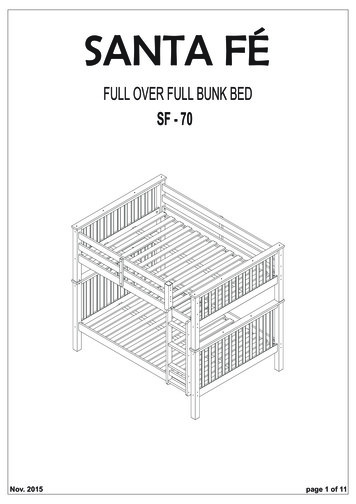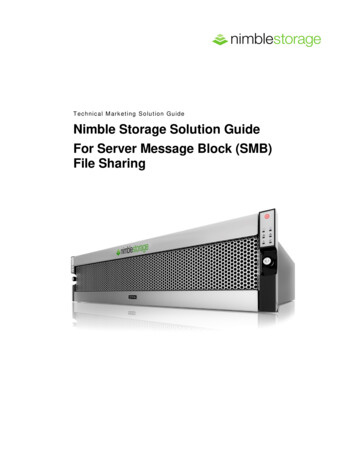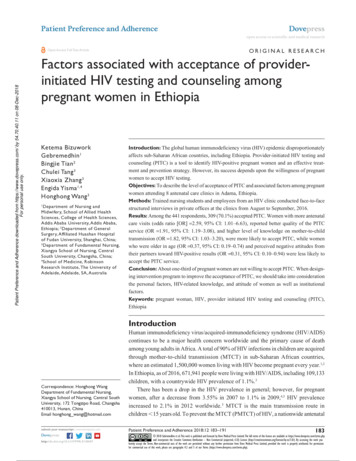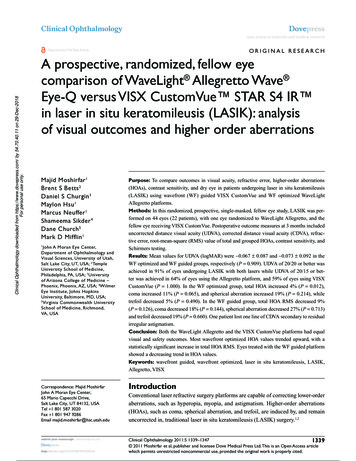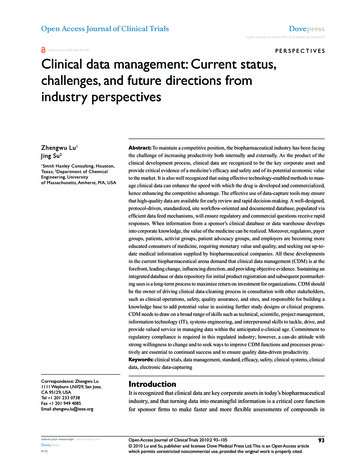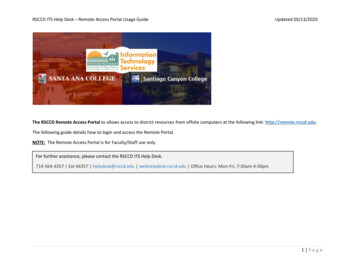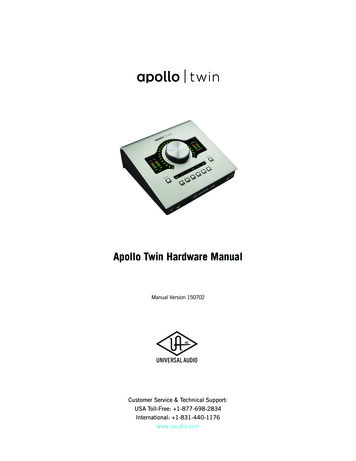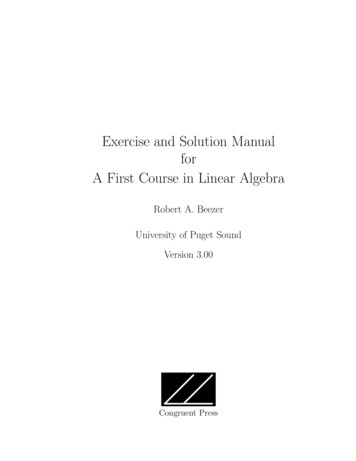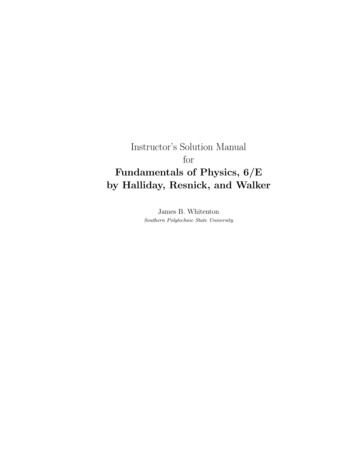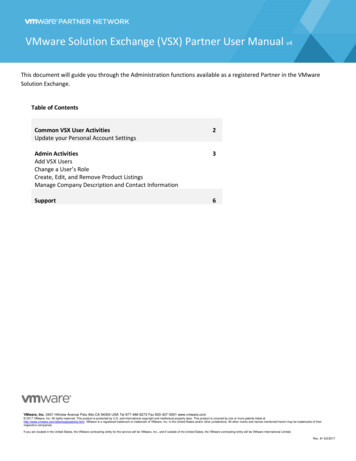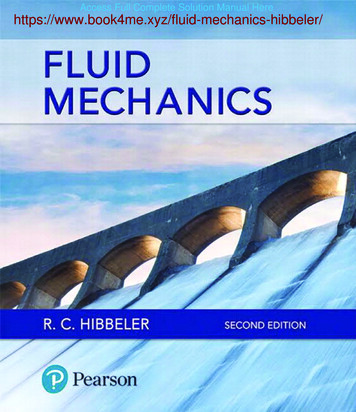
Transcription
Access Full Complete Solution Manual er/
luid MechanicsSecond EditionAccess forCompanion Website Thank you for purchasing a copy of Fluid Mechanics, Second Edition in SI Units, by R. C. Hibbeler. The one-timepassword below provides access to the video solutions found on the companion website.To access the companion website: 1.2.3.4. 5.Go to www.pearsonglobaleditions.com and search for this title.Click on “Companion Website”.Click on the “Register” button.Follow the on-screen instructions to establish your login name and password. When prompted, enter the access codegiven below. Do not type the dashes.Once you have registered, you can log in at any time by providing your login name and TANT: The access code on this page can be used only once to establish a subscription to the companionwebsite.Instructors:To access the material on the companion website, please contact your Pearson representative for an access code.
LUIDMECHANICSSECOND EDITION
his page intentionally left blank
LUIDMECHANICSSECOND EDITIONR. C. HIBBELERKai Beng Yap
enior Vice President Courseware PortfolioManagement: Marcia J. HortonDirector, Portfolio Management, Engineering, ComputerScience & Global Editions: Julian PartridgeSenior Portfolio Manager: Norrin DiasPortfolio Management Assistant: Michelle BaymanField Marketing Manager: Demetrius HallProduct Marketing Manager: Yvonne VannattaMarketing Assistant: Jon BryantManaging Producer, ECS and Math: Scott DisannoContent Producer: Sandra L. RodriguezProject Manager: Rose KernanEditor, Global Edition: Subhasree PatraOperations Specialist: Maura Zaldivar-GarciaSenior Manufacturing Controller, Global Edition:Caterina PellegrinoManager, Rights and Permissions: Ben FerriniComposition: Integra Software Services Private LimitedCover Designer: Lumina Datamatics LimitedCover Photo: Chaiyagorn Phermphoon/ShutterstockPearson Education LimitedKAO TwoKAO ParkHockham WayHarlowEssexCM17 9SRUnited Kingdomand Associated Companies throughout the world.Visit us on the World Wide Web at: www.pearsonglobaleditions.com. 2021 by R. C. Hibbeler. Published by Pearson Education, Inc. or its affiliates.The rights of R. C. Hibbeler to be identified as the author of this work have been asserted by him in accordance with theCopyright, Designs and Patents Act 1988.Authorized adaptation from the United States edition, entitled Fluid Mechanics, ISBN 978-0-13-464929-0, by R. C. Hibbeler,published by Pearson Education, Inc., 2018, 2015.All rights reserved. No part of this publication may be reproduced, stored in a retrieval system, or transmitted in anyform or by any means, electronic, mechanical, photocopying, recording or otherwise, without either the prior writtenpermission of the publisher or a license permitting restricted copying in the United Kingdom issued by the CopyrightLicensing Agency Ltd, Saffron House, 6–10 Kirby Street, London EC1N 8TS.Many of the designations by manufacturers and seller to distinguish their products are claimed as trademarks. Wherethose designations appear in this book, and the publisher was aware of a trademark claim, the designations have beenprinted in initial caps or all caps.The author and publisher of this book have used their best efforts in preparing this book. These efforts include the development,research, and testing of theories and programs to determine their effectiveness. The author and publisher make no warranty of anykind, expressed or implied, with regard to these programs or the documentation contained in this book. The author and publishershall not be liable in any event for incidental or consequential damages with, or arising out of, the furnishing, performance, or use ofthese programs.This eBook is a standalone product and may or may not include all assets that were part of the print version. It also does not provideaccess to other Pearson digital products like MyLab and Mastering. The publisher reserves the right to remove any material in thiseBook at any time.British Library Cataloguing-in-Publication DataA catalogue record for this book is available from the British Library.ISBN 10: 1-292-24730-4ISBN 13: 978-1-292-24730-4eBook ISBN 13: 978-1-292-24739-7Typeset by Integra Software Services Pvt Ltd.
o the StudentWith the hope that this work will stimulatean interest in Fluid Mechanicsand provide an acceptable guide to its understanding.
https://www.book4me.xyz/fluid-mechanics-hibbeler/P R E FA C EIt is hoped that this book will provide the student with a clear andthorough presentation of the theory and applications of fluid mechanics.In order to achieve this objective, I have incorporated many of thesuggestions and comments from the book’s reviewers, universitycolleagues who have e-mailed me, and from my students. Some of themore important improvements are listed below.New to This Edition Rewriting of Text Material. The purpose here is to achieve a furtherclarification of the material throughout the book, either with anexpanded discussion, or by deleting material that seemed not relevantto a particular topic. Expanded Topic Coverage. The material in Chapters 1, 3, 5, 7, 10, and 11have enhanced discussion on some topics, including additional data inthe tables in Chapters 10, 11, and 12. New Example Problems. The addition of new examples to Chapters 7and 10 further illustrate the applications of the theory. Many of the examplesthroughout the book have been expanded for clarification. New Fundamental Problems. These problems have been added toChapter 10 to enhance the student’s understanding of the theory and itsapplications, and to provide a review of the material that can be used tostudy for various engineering exams. New Photos and Enhanced Art. Many new photos and figures havebeen added to help the student obtain a better understanding of thesubject matter. New Equation Summaries. These are found at the end of Chapters 7, 11,12, and 13 so that students may use formula sheets when taking examsthat require application of some key equations.Besides the new features mentioned, other outstanding features thatdefine the contents of this book include the following.Organization and Approach. Each chapter is organized into well-defined sections that contain an explanation of specific topics, illustrativeexample problems, and at the end of the chapter, a set of relevant homeworkproblems. The topics within each section are placed into subgroups definedby boldface titles. The purpose of this organization is to present a structured
r e fa c emethod for introducing each new definition or concept, and to make thebook a convenient resource for later reference and review.Procedures for Analysis. This unique feature provides the studentwith a logical and orderly method to follow when applying the theory thathas been discussed in a particular section. The example problems are thensolved using this outlined method in order to clarify its numericalapplication. Realize, however, that once the relevant principles have beenmastered, and enough confidence and judgment has been obtained, thestudent can then develop his or her own procedures for solving problems.Important Points. This feature provides a review or summary of themost important concepts in a section, and highlights the most significantpoints that should be remembered when applying the theory to solveproblems. A further review of the material is given at the end of the chapter.Photos. The relevance of knowing the subject matter is reflected bythe realistic applications depicted in the many photos placed throughoutthe book. These photos are often used to show how the principles of fluidmechanics apply to real-world situations.Fundamental Problems. These problem sets are selectively locatedjust after the example problems. They offer students simple applications ofthe concepts and therefore provide them with the chance to develop theirproblem-solving skills before attempting to solve any of the standardproblems that follow. Students may consider these problems as extendedexamples, since they all have complete solutions and answers given in theback of the book. Additionally, the fundamental problems offer studentsan excellent means of preparing for exams, and they can be used at a latertime to prepare for various engineering exams.Homework Problems. The majority of problems in the book depictrealistic situations encountered in engineering practice. It is hoped that thisrealism will both stimulate interest in the subject, and provide a means fordeveloping the skills to reduce any problem from its physical description to amodel or symbolic representation to which the principles of fluid mechanicsmay then be applied.Throughout the book, all problems use SI units. Furthermore, in any set,an attempt has been made to arrange the problems in order of increasingdifficulty. Except for every fourth problem, indicated by an asterisk (*),the answers to all the other problems are given in the back of the book.Conceptual Problems. Throughout the text, usually at the end ofmost chapters, there is a set of problems that involve conceptual situationsrelated to the application of the principles contained in the chapter.These problems are intended to engage students in thinking through areal-life situation as depicted in a photo. They can be assigned after thestudents have developed some expertise in the subject matter and theywork well either for individual or team projects.7
/r e fa c eAccuracy. Apart from my work, the accuracy of the text and problemsolutions have all been thoroughly checked by other parties. Mostimportantly, Kai Beng Yap, Kurt Norlin of the Bittner DevelopmentGroup, as well as Pavel Kolmakov and Vadim Semenenko at Competentum.The SI edition has been checked by three additional reviewers.CONTENTSThe book is divided into 14 chapters. Chapter 1 begins with an introductionto fluid mechanics, followed by a discussion of units and some importantfluid properties. The concepts of fluid statics, including constant acceleratedtranslation of a liquid and its constant rotation, are covered in Chapter 2.In Chapter 3, the basic principles of fluid kinematics are covered. This isfollowed by the continuity equation in Chapter 4, the Bernoulli and energyequations in Chapter 5, and fluid momentum in Chapter 6. In Chapter 7,differential fluid flow of an ideal fluid is discussed. Chapter 8 coversdimensional analysis and similitude. Then the viscous flow between parallelplates and within pipes is treated in Chapter 9. The analysis is extended toChapter 10 where the design of pipe systems is discussed. Boundary layertheory, including topics related to pressure drag and lift, is covered inChapter 11. Chapter 12 discusses open channel flow, and Chapter 13 coversa variety of topics in compressible flow. Finally, turbomachines, such asaxial and radial flow pumps and turbines are treated in Chapter 14.Alternative Coverage. After covering the basic principles ofChapters 1 through 6, at the discretion of the instructor, the remainingchapters may be presented in any sequence, without the loss of continuity.If time permits, sections involving more advanced topics, may be includedin the course. Most of these topics are placed in the later chapters of thebook. In addition, this material also provides a suitable reference forbasic principles when it is discussed in more advanced courses.ACKNOWLEDGMENTSI have endeavored to write this book so that it will appeal to both thestudent and instructor. Through the years many people have helped in itsdevelopment, and I will always be grateful for their valued suggestionsand comments. In particular, along with R. Sultana, California StateUniversity, Long Beach, J. Karl, University of South Florida, and C.Dreyer, Colorado School of Mines, the following individuals havecontributed important reviewer comments relative to preparing this work:H. Gallegos, California State University, LAK. Lamb, California State Polytechnic University, PomonaA. Polebitski, University of Wisconsin-PlattevilleN. Lu, Colorado School of MinesM. Widdowson, Virginia TechA. Shalaby, Howard UniversityL. Grega, The College of New Jersey
r e fa c eR. Hotchkiss, Brigham Young UniversityS. Kumpaty, Milwaukee School of EngineeringJ. Liburdy, Oregon State UniversityS. K. Venayagamoorthy, Colorado State UniversityJ. Chen, Temple UniversityK. Anderson, California State Polytechnic University, PomonaT. Olenik, New Jersey Institute of TechnologyK. Hodge, Mississippi State UniversityE. Petersen, Texas A&MW. Rahmeyer, Utah State UniversityD. Corti, Purdue UniversityN. Moore, North Carolina State UniversityS. Hilgenfeldt, University of Illinois—Urbana ChampaignThere are a few people that I feel deserve particular recognition. Alongtime friend and associate, Kai Beng Yap, was of great help in checkingthe entire manuscript, and helping to further check all the problems. Anda special note of thanks also goes to Kurt Norlin, and Viktoria Sirotovaand all those at Competentum, for their diligence and support in thisregard. During the production process I am also thankful for the supportof my long time Production Editor, Rose Kernan, and my ManagingEditor, Scott Disanno. My wife, Conny, has been a big help with theproofreading and typing needed to prepare the manuscript for publication.Lastly, many thanks are extended to all my students and colleaguesthat have e-mailed me their suggestions and comments. Since
Access Full Complete Solution Manual Here. Fluid Mechanics Second Edition Thank you for purchasing a copy of Fluid Mechanics, Second Edition in SI Units, by R. C. Hibbeler. The one-time password below provides access to the video solutions found on the companion website. To access the companion website: 1. Go to www.pearsonglobaleditions.com and search for this title. 2. Click on
